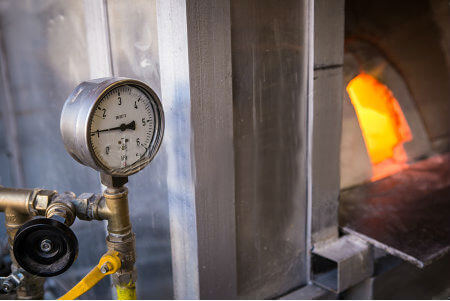

Glass certainly is one of the most popular choices for building and construction materials, thanks to its virtually countless aesthetic options coupled with optimal performance.
Today more than ever, builders, architects, and designers are given more choices of high-quality products. Every time you pick glass for construction or remodeling, you have the opportunity to turn a project stronger, better-looking, and smarter.
Image courtesy of Shutterstock.com
What usually ends up as massive, sweeping panels in healthcare facilities, high-rise buildings, schools, commercial establishments, and other construction projects firstly begins with mountains of sand, limestone, soda ash, dolomite, and select raw ingredients, heated to create a flat ribbon of glass with optimal clarity, light transmission, and integrity for fabrication and treatments.
In a series of steps, witness the float glass manufacturing process unfold, from raw materials entering the line at one end to glass plates emerging and being precisely cut at the other.
Step 1: Melting and Refining
Starts as a mixture of silica sand and some other raw materials. Closely monitored and controlled for quality, these fine-grained ingredients are combined together and heated to make molten batches of glass.
Several processes simultaneously take place in the 2000 molten glass tonnes in the melting furnace. This is very similar to an old-fashioned brick oven only much, much more massive.
Melting: the weighed batch of raw materials is melted at around 1500 degrees Celsius by a combination of pre-heated air and natural gas jet streams. This combo produces torch-like flames that melt the ingredients in a matter of minutes.
Refining: The molten ingredients are then homogenized and bubbles of gas are removed as the liquid glass moves through a canal.
Temperature control: The molten glass is made cooled enough to be able to draw it into what is known as the tin float bath.
All driven by high temperatures, these processes occur in separate zones and last for up to 50 hours in total. Before the bubble- and inclusion-free glass is smoothly delivered at 1100 degrees Celsius from the furnace to the float bath.
This stage is the most crucial as it is the key to the product’s quality. It is also during this phase when the glass composition can be modified to alter the final product’s properties.
Step 2: Tin Float Bath
The liquid glass flows over a sprout and floats onto the mirror-like surface of a shallow pool of molten tin at about 1000 degrees Celsius. The glass is highly viscous at this phase, so it does not combine with the liquid tin, creating a relatively flat ribbon of glass.
Its uniform thickness is controlled by reducing or increasing the speed at which it spreads while its width is maintained by the machine’s edge rollers. The ribbon of glass is made and then leaves the float tank at 600 degrees Celsius.
While the principle of float glass has remained the same for decades, the finished product has not. From a product often marred by bubbles to one that is optically perfect as well as from delivering a single uniform thickness to producing an array of thickness options that range from sub-millimetre to 25mm, the modern float glass is made process has certainly improved.
Step 3: Annealing
The ribbon continues to move along and solidifies slowly in the annealing chamber.
During the cooling process, considerable stresses may develop in the glass is made. If too much stress builds up, then the cooled glass will break beneath the cutter. To avoid the stresses, the glass passes through a heat treatment tunnel known as a lehr. In this chamber, the temperature of the ribbon is closely controlled. And gradually lowered to 250 degrees Celsius to produce annealed.
As it comes out of the enclosed lehr, the ribbon is further cooled and hardened by forced air before the inspection.
Step 4: Quality Inspection
To ensure the highest product quality, scanners examine the hardened ribbon to identify imperfections.
While the float process is known for producing flawless glass. There are rare occasions. Where a bubble or inclusion may have been missed during the refining stage, a grain of sand may have refused to melt. Or a tremor in the float bath may have caused ripples in the ribbon. Through quality on-line inspections, these faults are revealed and discarded.
Step 5: Cutting and Lift Off
As the ribbon moves along the conveyor rolls, its edges are trimmed off by diamond wheels. And the glass is made precisely cut to customer-specific dimensions at rates as high as 6000 tonnes a week. The automatically-cut sheets. Then lifted off by robotic arms and stacked into racks, cases, or packs all set to be coated or delivered to customers.
Float is generally sold per square metre. Computers translate the customer’s specifications into the automated cutter. Which cuts the ribbon of glass is made in patterns designed to reduce wastage.
Step 6: Coating
This is the stage where a variety of coatings to improve. The thermal and solar performance of the glass can be applied. Some manufacturers deposit coatings in the glass during the early stages of the float process. But coating application is usually done when this is cut to precision.
Manufacturers use an advanced high-temperature technology called on-line chemical vapour deposition. Or CVD to lay down these various micron thick coatings onto the finished product. Making profound alterations in its optical properties.
Step 7: Dispatch
Once multiple coatings are applied, they are stacked onto vehicles ready for dispatch. This final stage of the float manufacturing process involves lading the cases of panes onto trucks or into open-top containers and then shipping the orders to the customer.
To know more about glass. If you have any other questions on how the float glass process works, send us an email.
